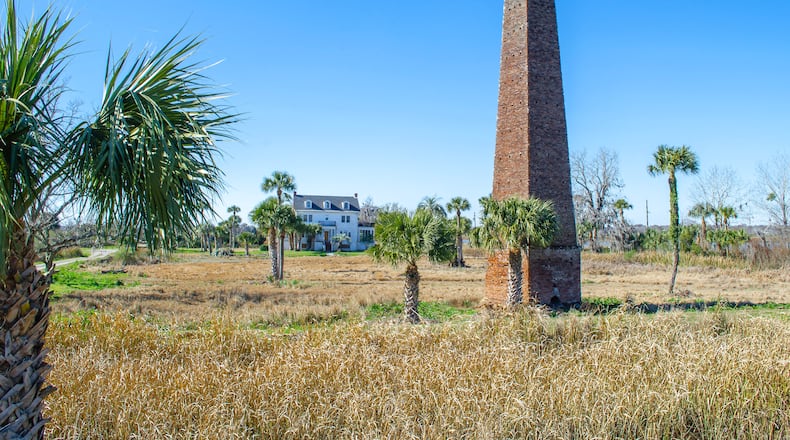One mile south of Darien on U.S. Highway 17, in front of the remnants of a brick cistern, sits a historical marker for the Butler Island Plantation.
Dedicated in 1957 by the Georgia Historical Commission, the plaque cites plantation owner Pierce Butler, the “system of dikes and canals for the cultivation of rice, installed by engineers from Holland” and Butler’s wife, “the brilliant English actress” Fannie Kemble, who authored “Journal of a Residence on a Georgia Plantation.”
It does not mention the more than 900 estimated enslaved men, women and children forced to live and work on the plantation established by Butler’s grandfather, Major Pierce Butler — one of the Founding Fathers of this nation.
A few paces away from that historical marker and in front of the remains of a rice mill visible from the highway is a different marker. Erected in 2019 by the Georgia Historical Society, The Vanderkloot Fund and the Lower Altamaha Historical Society, the signage acknowledges the enslaved people of Butler Island: Hundreds of enslaved Africans produced millions of pounds of rice at Butler Island Plantation during the 19th century. Working under extreme conditions in a difficult environment, the slaves dug canals and irrigation ditches, built tide gates and cultivated and harvested rice. In March of 1859, 436 men, women and children were sent to Savannah to be sold in order to pay off debts incurred by plantation owner Pierce M. Butler. This was the largest sale of human beings in U.S. history, known as the “Weeping Time.” After the Civil War, some of the formerly enslaved workers returned to Butler Island as freedmen and resumed rice production —working for wages and, in some cases, purchasing nearby land. Many of their descendants remain in the area to this day.
Standing near the site of the sale at the Ten Broeck Race Course outside Savannah, where the enslaved men, women and children of Butler Island Plantation were detained in holding pens for a week to be inspected like cattle by potential buyers, Kwesi DeGraft-Hanson gets chills.
Since about 2017, DeGraft-Hanson has helped organize annual commemorative events around the dreadful anniversary.
“I can feel the anguish and the pain that they went through,” said DeGraft-Hanson, who lives in the Atlanta area. “Being from Ghana, I was taught the importance of respecting elders, even those who have transitioned. So while they are physically gone, they are still present.”
Earlier this month, Butler Island Plantation was one of the sites of the annual Weeping Time Commemoration events that honor the 1859 sale of the enslaved people of Butler Island Plantation through panel discussions, nighttime lighting ceremonies and other gatherings.
Called “The Weeping Time,” in part because it rained over the course of the two-day auction, it is not hard to imagine what else might have led to the name. In selling 436 human beings, who were then spread out onto plantations throughout the South to tend rice and cotton, Pierce Butler made $303,850, just under $8.4 million in today’s dollars. It served to recoup his and his brother’s lost fortune that they squandered on lavish living and gambling.
Few people had heard about what historians call the largest slave sale in American history until DeGraft-Hanson, who taught architectural landscaping at the University of Georgia for two decades, started researching it in 2007. Now multiple events are held across Savannah every year in early March to memorialize the event.
The next event to honor enslaved people is the Butler Island Day Commemoration scheduled for Oct. 7. Now in its third year, this free outdoor gathering held on the grounds of the former plantation includes music, storytelling, food and a walking tour.
”The wounds of slavery are still with us and to turn those wounds into scars, we must heal,” DeGraft-Hanson said. “It is an ongoing process, but we still have a long way to go.”
For information about Butler Island Plantation commemorative events go to butlerislandplantation.org.
Keep Reading
The Latest
Featured




